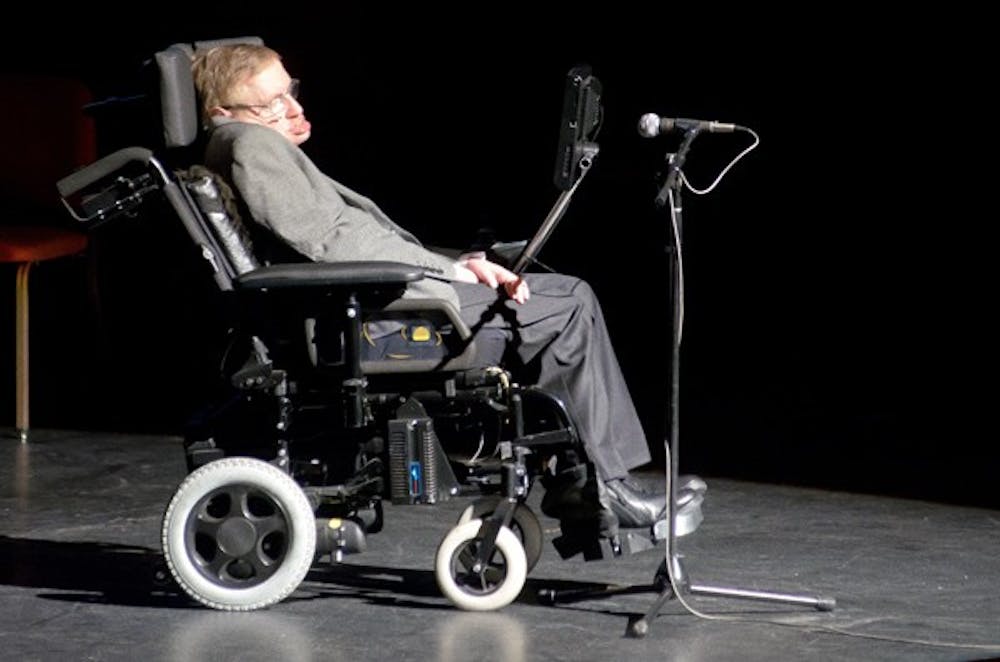Hundreds of people filled Gammage Auditorium on Saturday night for a narrated multimedia presentation set to an orchestral performance of Gustav Holst’s “The Planets,” followed by a lecture by Stephen Hawking.
Hawking, author of books such as “A Brief History of Time” and, more recently, “The Grand Design,” spoke about his own life and what inspired him to choose a life of science.
Hawking, who is in a wheel chair and speaks with the help of communication technology because of a degenerative motor neuron disease, said his disability pushed him to work harder.
“When you are faced with the possibility of an early death, it makes you realize that life is worth living, and there are lots of things you want to do,” Hawking said.
His speech was punctuated by laughs from the audience as he poked fun at himself while sharing stories about his life and scientific discoveries.
Hawking’s early work focused on singularities, points where space and time come to an end. As Hawking progressed, he started researching and theorizing about the basic laws that govern the universe.
Eventually, Hawking discovered that black holes, areas of space from which nothing can escape, emit radiation, and therefore eventually disappear. He said he would like the formula for his discovery to be on his tombstone.
Hawking ended his lecture saying there is nothing like the Eureka moment of discovering something new.
“I wouldn’t compare it to sex, but it lasts longer,” he said.
Before Hawking spoke, images and animations of planets and their moons were timed to the music of “The Planets” and projected onto a big screen above the orchestra, providing a visual experience for the most-performed piece of English music.
The event was part of the ASU Origins Project, a trans-disciplinary program that explores questions of the universe and life while inspiring further scientific research and education.
Lawrence Krauss, a theoretical physicist who teaches at the School of Earth and Space Exploration and directs the ASU Origins Project, said the goal of the event was to inspire people by connecting science and culture.
“I want to provoke people to think about this pale blue dot we live on, on the edge of a galaxy in the middle of nowhere, and how fortunate we are to be around and to be thinking so we can make the most of our lives,” Krauss said.
Science is no different from art, music, literature and film in its purpose to force people to reflect on their place in the universe, Krauss said.
He said he brought “The Planets” to ASU because he did similar successful events with the Cleveland Orchestra, and because the music is powerful and accessible. He also wants to show that the University is a cultural resource that can host events unlike anywhere else in the world.
The musical suite is composed of seven movements, each representing a different planet.
Earth was not included because Holst was using music to explore astrological concepts of each planet, and Earth is not observed astrologically, said William Reber, a music professor who conducted the orchestra.
Krauss narrated between each movement, telling facts about the planets and preparing audience members for what they were about to see and hear.
About 100 musicians from the ASU Symphony Orchestra performed “The Planets,” making the event one of the biggest in the orchestra’s history, Reber said.
To end the performance, 70 women from the ASU Choral Union sang offstage, their voices intertwining and eventually fading as a lone satellite was shown drifting in space.
Though “The Planets” is nearly 100 years old, Reber said it was a precursor to a lot of modern film scores, like in “Star Wars.”
“I keep threatening to hand out Darth Vader masks every time we play ‘Mars,’ because without ‘Mars,’ Darth Vader and the imperial march in ‘Star Wars’ wouldn’t have happened,” Reber said. “It’s basically a rip-off of it.”
Combining music with science seemed natural to Reber, who said music is like a science in many ways.
“It’s because much of what we do is based on scientific theory and harmonic relationships or simply numbers patterns,” Reber said.
“The Planets” is an emotional piece of music that explores a variety of subjects; it evokes brutality and peace, love and war, youth and age, momentary life versus eternity, Reber said.
“Music often picks up where words leave off,” Reber said. “If you’re trying to express an emotion — whatever kind, positive or negative — you reach a point where words no longer get the job done.”
The music, combined with images and animations from NASA and the Jet Propulsion Lab, was a good way to provide perspective on life, he said.
“There’s nothing that demonstrates eternity quite as quickly as looking at objects in space that have been there for several hundred million years,” Reber said.
Reach the reporter at kkfrost@asu.edu






